|
Start your tour with a small group through the winter wonderland of the Yukon Territory. Overnight in Whitehorse, a trip on the Alaska Highway to Watson Lake, visit Liard Hot Springs with its natural hot springs pools, stay over in Watson Lake and visit the Northern Lights Space and Science Center and spend a few days in Dawson City. The former " Paris of the North" is synonyms with the 1898's Klondike Gold Rush and the author Jack London who lived here from 1897/98. You'll finally end the tour at the Takhini Hot Springs with the 35-40 degree heated pools and many recreational activities and over 300 acre of ski trails. Return to Whitehorse. |
NL#13 Yukon Territory | Northern Lights Safari
Tour Itinerary
Dates | Rates
Options | Extensions
Northern Lights FAQ
|
Day
01 |
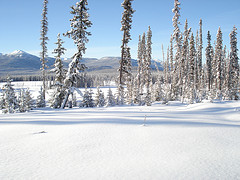 |
Whitehorse Travel with a small group and a bi-lingual tour guide (English & German) through the winter wonderland of northern Canada's Yukon Territory. You'll visit some remarkable areas, enjoy excellent sightseeing and meet locals who live here under very extreme climatically conditions. Upon arrival transfer from the airport to your hotel located within the city of Whitehorse. In the afternoon city-tour and visit of the Beringia Museum and Interpretive Center (included) - a voyage into the past gold rush days - and the SS-Klondike (Included) - a sternwheeler which represents an age when Whitehorse served as transport hub for the entire region taking miners on the Yukon River to the goldfields around Dawson City. Overnight: Whitehorse. |
|
Day
02 |
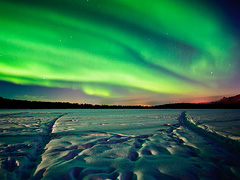 |
Whitehorse - Watson Lake Today we drive 420 km of the famous Alaska Highway towards Watson Lake. Photo stops along Marsh Lake, the first nation village of Teslin and the Rancheria Mountains. Since there are still a lot of trappers in the Yukon we stop at the cabin of trapper Don on the Tootsee River. In the afternoon arrival in Watson Lake and check-in the hotel. Watson Lake is well known for its "Signpost" started in 1942 by a homesick US Army Soldier. The 1996 build Northern Lights Space and Science Center boasts a State-of-the-Art panoramic video and surround-sound system. It incorporates interactive displays explaining science and folklore of the Aurora, along with the latest information about the Canadian Space Program. The nightly skies are illuminated by spectacular Northern Lights displays. Overnight: Watson Lake. |
|
Day
03 |
 |
Watson Lake – Liard Hot Springs - Watson Lake Trip to the Liard Hot Springs. One of the best stops on the entire Alaska Highway are the fabulous Liard River Hot Springs, located in the Liard River Hotsprings Provincial Park - north of Muncho Lake. Relaxation seeps into your body as you ease into the second largest hot spring in Canada. In a natural boreal forest surrounding a soak in these Hot Springs is an exceptional experience in an incredible winter wonderland. Watch out for Moose frequently seen in the area. There are two hot springs at Liard, with water temperatures ranging from 42-52 degrees C (107-126F). The nearest is the Alpha pool, and half a mile beyond that is Beta pool, which is larger and deeper, and is likely to have few other people there. Return to Watson Lake. In the evening we will go curling in the Watson Lake Recreational Centre. Overnight: Watson Lake. |
|
Day
04 |
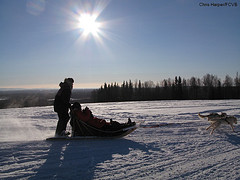 |
Watson Lake - Whitehorse After Breakfast we leave Watson Lake and visit on snowshoes the Rancheria Falls. We plan a lunch stop in the native village of Teslin - bordered by the waters of the Nisutlin and Teslin Rivers - or in Johnsons Crossing. By 1903 the Hudson Bay Company closed the important trading post. The Teslin Lake is 125 km long with a depth of nearly 213 meters. After dinner in Whitehorse we will drive up for 25 minutes to a heated cabin - away from the disturbing city lights of Whitehorse - on Fish Lake to observe spectacular Northern Lights displays. There will be a campfire outside around and roast marsh mellows and enjoy the quiet and clear winter night. Return to the city. Overnight: Whitehorse. |
|
Day
05 |
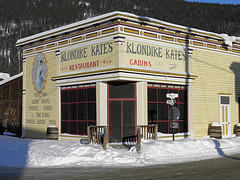 |
Klondike Highway - Dawson City We'll drive up north for 530 km along the Klondike Highway to the famous gold rush town of Dawson City. Interesting stops at Braeburn Lodge and the first nation village of Carmacks - both are serving also as checkpoints for the famous Yukon Quest Sled Race, Five Finger Rapids and the Dempster Highway Crossing. Upon arrival in Dawson we visit the famous local bar "The Pit". Dawson City is a well preserved, living and breathing cultural and historic oasis tucked away in the middle of the Yukon wilderness. Once referred to as the "Paris of the North", its name is synonymous with the 1898's Klondike Gold Rush. This "must see" northern icon should be included in any Alaska/Yukon itinerary. Overnight: Dawson City |
|
Day
06 |
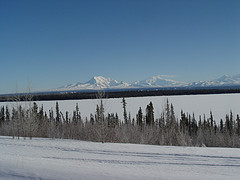 |
Dawson City Usually the Yukon River freezes solid around November/December and an ice bridge is built which we will cross with the Van. An excursion to the Bonanza Gold fields and to the Midnight Dome will follow. Later on we invite you to a snowshoe tour to "Cave Man Bill" who lives in a cave on the western shore of the Yukon River. Or you can discover Dawson on your own. The City of Dawson and the nearby ghost town of Forty Mile are featured prominently in the novels and short stories of famed American author Jack London, who lived in the Dawson area from October 1897 to June 1898. During these days Dawson City was a thriving city of 40.000 In 1899 the gold rush was over and the population dropped to 8.000 One of the books it's been featured in is the beloved book "The Call of the Wild". Overnight: Dawson City |
|
Day
07 |
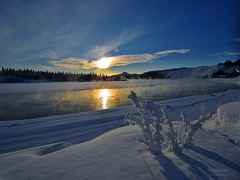 |
Dawson City - Takhini Hot Springs - Whitehorse We drive back on the Klondike Highway to Whitehorse. Short before we are arriving in Whitehorse we will visit the Yukon Wildlife Preserve, which features an array of local wildlife. During a visit of Takhini Hot Springs about 30 Km from Whitehorse - also known as the "Yukon Hotspot" you can relax and soak in the warm spring water without any sulphur smell and with a wonderful view of the snow covered mountains around you. The hot springs are offering a range of recreational activities on over 300 acres: x-country ski trails, two connected hot pools with 35-40 degree water temperature and of course - perfect Aurora viewing from October to March. Return transfer to Whitehorse. Overnight: Whitehorse. |
|
Day
08 |
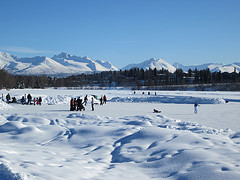 |
Whitehorse Whitehorse is located at Historic Mile 918 of the Alaska Highway and is the former terminus of the White Pass and Yukon Route Railway from Skagway, Alaska. At the head of navigation on the Yukon River, the city was an important supply and centre during the Klondike Gold Rush. It has been the territorial capital since 1953, when the seat was moved from Dawson City after the construction of the Klondike Highway. Whitehorse is in the mountain climate region, the tundra soil region, the Arctic vegetation region, and the boreal cordillera eco zone. The city gets its name from the White Horse Rapids, which were said to look like the mane of a white horse. Alternate stories have the rapids named after a First Nations Chief who drowned while crossing the rapids. Our tour ends in the morning of day 8 with a complimentary transfer to the airport. |
| Rates in US $ / per Person | Single | Double | Triple | Quad | Child |
| January 01 – March 26 | Departures Saturday | $ 2900.00 | $ 2480.00 | n/a | n/a | n/a |
|
| Rates in US $ / per Person | Single | Double | Triple | Quad | Child |
| February 01 – April 12 | $ 249.00 | $ 199.00 | n/a | n/a | n/a |
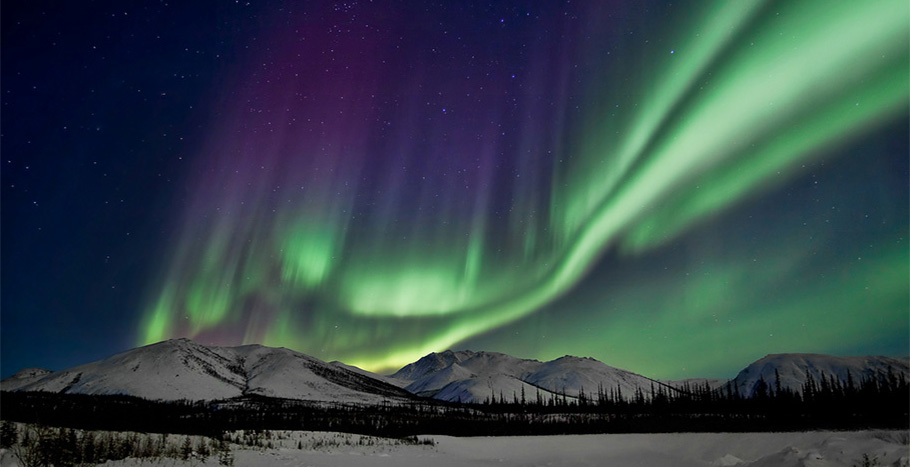
▶ Northern Lights Viewing in Alaska | Canada – New Moon Dates Overview
Ideal viewing time is approximately from 7 days prior to New Moon and until 7 days after New Moon. While some people may be concerned that a full moon is a problem, only weak aurora may be obstructed by the light of the moon, but in Alaska the aurora is frequently strong enough that aurora viewing is still possible on a moonlit night. As far as aurora photography goes, the aurora above a moonlit landscape actually tends to have a pleasing effect. On the whole, when participating in an aurora tour, one doesn’t need to be worried about the moon.The moon does not influence the aurora activity, the sky is just darker. You can therefore travel any time of the month.
Aurora Photography:
When you do your research for shooting the aurora, you’ll find pluses and minuses for going when a full moon is present. On the minus side is if the lights that night are somewhat faint, the brightness of the moon’s reflection of the sun can fade them out. On the other hand, a full moon can be used to illuminate objects in the foreground. Many aurora shots include buildings with lights on inside to provide an interesting foreground subject. Depending on your shooting location, this feature might not be available. However, a full moon will help light up anything you have in front of you, no matter where you are. Because shots are done for at least six to eight seconds and up to fifteen seconds or more (depending on your shutter and ISO settings), the full moon will do a great job of making what would otherwise be a silhouette into a well-lit subject. Conversely, if you choose to go when there isn’t a full moon, a strong flash can be helpful in popping light onto a foreground subject.
▶ Aurora Viewing | Prime Viewing Dates
Q: When is the best time of the year to see the Aurora
A: In northern regions such as Alaska, the Yukon Territory, Northern British Columbia and the Northwest Territories - the Northern Lights (Aurora Borealis) are seen from late August to mid April. Furthermore, during the autumn and spring, the weather is rather unstable and has a lower percentage of clear skies. Therefore, we have determined the best viewing seasons to be from mid-August to the end of September and from mid-November to mid-April. In This time of the year offers the best trade off between mild weather and dark skies. During the summer months, night skies are not dark enough to view the Aurora Borealis and in midwinter temperatures in the – 40 degree range make outdoor aurora viewing somewhat unpleasant. In other locations farther from the average aurora oval, the main consideration is the level of geomagnetic activity, which varies rather unpredictably through the year.
Q: When is the best time of the day
A: Within the most active regions of Alaska and prime viewing areas the Aurora oval typically becomes visible around local midnight. Note: this is an astronomical midnight - which may be an hour or two different from the civil or the “ wall clock “ midnight due to daylight savings time and/or peculiarities in your time zone. Spectacular Aurora displays due to geomagnetic disturbance may be seen at any time when the sky is dark, but they are relatively unpredictable. Under average conditions, observations around local midnight are most likely to yield results.
Q: What are the Temperatures in the Northern Regions
A: The average daily temperatures in February/March are approximately +20/-30 - equivalent to –8/-33 degrees Celsius.
Q: How to observe the Aurora
A: If you follow our recommendations you should be able to enjoy some pleasant Aurora viewing.
- A: Ensure - that you be there when the action begins. Because more often than not, the show picks up very quickly and also fades out as quickly as it started! Most of the auroras are out only about 2 to max 10 minutes at ones.
- A: Be Patient - this is maybe the most important thing in aurora viewing. If the show starts, it's always worth. Seeing a full-blown aurora show is just an indescribable experience.
- A: Experience - this is maybe the second most important (human) factor in aurora viewing. If you are first patient and then successful in seeing auroras, the direct consequence is that you will gain of course - experience. After a while you will begin to recognize what the aurora is doing, in which phase it is and so on. And the most important thing - You will learn how a weak aurora looks like!!! Because, even that we are hoping to see a bright "eruption phase " aurora, the aurora isn't all the time bright. So the experience will help you to see and determine if there is a weak aurora, which could get brighter in the future! I
- A: Light Conditions - the primary reason for not seeing an aurora are any city light obstruction or a bright twilight. Our destinations are far away from a city or other light obstruction and therefore should guarantee the best viewing conditions possible.
- A: Weather - don't think overcast weather prevent you from Aurora viewing. Although often clouds do ruin everything, but at times...you can also get lucky breaks! Another example, during a major aurora storm in 2001 the forecasts and satellite pictures showed that it should be overcast, but it was not. We could see the stars and the aurora through the thin clouds! So, give it a try anyway...it could be worth it!
Q: What causes the Aurora
A: Energetic charged particles from the magnetosphere. These particles are electrons and protons that are energized in the near geo-space environment. This energization process draws its energy from the interaction of the Earth's magnetosphere with the solar wind. The magnetosphere is a volume of space that surrounds the Earth. We have this magnetosphere because of Earth's internal magnetic field. This field extends to space until it is balanced by the solar wind.
Q: What is the altitude of the Aurora Borealis
A: The bottom edge is typically at 100 km (about 60 miles) altitude. The aurora extends over a very large altitude range. The altitude where the emission comes from depends on the energy of the energetic electrons that make the aurora. The more energy the bigger the punch, and the deeper the electron get into the atmosphere. Very intense aurora from high-energy electrons can be as low as 80 km (50 miles). The top of the visible aurora peters out at about 2-300 km (120-200 miles), sometimes high altitude aurora can be seen as high as 600 km (350 miles). This is about the altitude at which the space shuttle usually flies.
▶ Sun | Solar Wind | Magnetosphere
The solar wind is the outermost atmosphere of our sun. The sun is so hot that it boils off its outer layers, and the result is a constant outward expanding very thin gas. This solar wind consists not of atoms and molecules but of protons and electrons (this is called a plasma). Embedded in this solar wind is the magnetic field of the sun. The density is so low that we may well call it a vacuum. However tenuous it is, when this solar wind encounters a planet, it has to flow around it. When this planet has a magnetic field, the solar wind sees this magnetic field as an obstacle, as protons and electrons cannot move freely across a magnetic field. These charged particles are constrained to move almost always only along the magnetic field. Likewise, when they are forced to move in a specific direction, a magnetic field will move with them or will be bent into the direction of the flow. Whether the magnetic field forces the plasma motion or whether the plasma motion bends the magnetic field depends on the strength of the field and the force of the motion. When the solar wind encounters Earth's magnetic field, it will thus bend the field unless the field gets too strong. The strength of the magnetic field falls off with distance from Earth. The distance at which the solar wind and the magnetic field of the Earth balance each other is about 60,000 km away, or 1/10 of the distance to the moon. The inside of this volume that is bounded by the solar wind is called the magnetosphere. At the interface of the solar wind and the magnetosphere, energy can be transferred into the magnetosphere by a number of processes. Most effective is a process called reconnection. When the magnetic field in the solar wind and the magnetic field of the magnetosphere are anti-parallel, the fields can melt together, and the solar wind can drag the magnetospheres field and plasma along. This is very efficient in energizing magnetospheres plasma. Eventually, the magnetosphere responds by dumping electrons and protons into the high latitude upper atmosphere where the energy of the plasma can be dissipated. This then results in aurora. Here is an animation (1.6Mb) that illustrates this process.
▶ Alaska and Canada Northern Lights Viewing | Photo Support
Q: How do I take the best pictures
A: For the first -time or for seasoned aurora photographer, a 35 mm camera on a tripod equipped with a cable release is a must. Use a wide-angle 24 mm to 50 mm lens and set it to an f-stop which is the fastest – or one slower to avoid distortion of bright star images – usually f/1.4 – f/2.8.
- Exposures of 5 to 15 seconds work well unless the aurora is faint or mostly stationary, in which case the exposure time should be doubled. People tend to overexpose their photos, causing the aurora to look washed out. If the aurora is bright, moonlight and city lights should not interfere and can offer an interesting foreground. Never use filters because they could cause internal reflections. If it is very dark, a silhouette of a tree of lit cabin will certainly add to the scene. Video cameras are normally not sensitive enough to successfully record the aurora.
- Because aurora occurs under clear skies, photographers will often be shooting in temperatures well below zero. Since cold saps camera batteries, it is advisable to use an older camera with mechanical shutter instead of one that is fully automatic. Cold makes plastic brittle, so the cable release should be wired mesh vice plastic. At minus 40 Fahrenheit, all cameras will freeze in less than 10 minutes; before taking it inside to warm, place it in a zip-lock plastic bag to reduce condensation.
- Tape the lens to infinity so that it doesn’t slip and cause your images to be out of focus. Don’t try for a 37th exposure; it might break the film, and it is best to overexpose your first frame on the roll so that the film processor knows where to start cutting your negatives. Wind your finished roll of film slowly so that it doesn’t shatter or cause static buildup – this may appear as scratch. While Kodak film processing mailers are generally reliable, it may be worth the extra cost to have the film processed through a custom photo lab. Going the custom lab route will save the film from being lost in the mail or scratched in an automated process.
- Slower speed film (print or slide) has better gain resolution; making for a sharper image when enlarged. Thus it may be too slow to record the fine detail structure of the aurora.
- Medium-speed color film (200 /400 ASA) works as well. Purists insist on slide film. You can try a faster film, but keep in mind that graininess and color quality tend to decrease with increasing film speed. We recommend using 400-speed film is a good compromise between detail and quality of the image.
- Different films will emphasize different colors of the aurora, so experimentation is advisable. Bracketing your exposures (05 seconds, 10 seconds and 15 seconds) will give you the characteristics of the film. Even in a roll of 36 exposures, there are only a few shots that are acceptable to me.
Q: Can I videotape the Aurora
A: Videotaping the aurora generally takes highly specialized video equipment. Generally – camcorders are not sensitive enough to see the aurora, though a few will record a faint, smoky image given a sufficiently bright aurora. Your best bet for video showing the color and motion of the aurora is to purchase a professionally – recorded tape such as one distributed form the Geophysical Institute in Fairbanks. Thus, some home video cameras are capable of picking up bright auroras. In particular, a camera rated at for example: less than one-lux sensitivity has captured – faintly and colorlessly a bright auroral arc. Many cameras which have special features such as digital zoom and / or vibration compensation are much less sensitive and will not show the aurora. The most annoying problem with home video cameras in low-light situations is their inability to focus. If your camera has a focus-lock button, you may be able to focus on a distant, brightly-lit object, and lock the focus then see if you can pick up the moon or perhaps catch a hint of an extremely bright aurora. Just don’t expect much, because home video cameras aren’t designed to do low-light recording.
Q: Do you have any Aurora Photography Tips
A: When you do your research for shooting the aurora, you’ll find pluses and minuses for going when a full moon is present. On the minus side is if the lights that night are somewhat faint, the brightness of the moon’s reflection of the sun can fade them out. On the other hand, a full moon can be used to illuminate objects in the foreground. Many aurora shots include buildings with lights on inside to provide an interesting foreground subject. Depending on your shooting location, this feature might not be available. However, a full moon will help light up anything you have in front of you, no matter where you are. Because shots are done for at least six to eight seconds and up to fifteen seconds or more (depending on your shutter and ISO settings), the full moon will do a great job of making what would otherwise be a silhouette into a well-lit subject. Conversely, if you choose to go when there isn’t a full moon, a strong flash can be helpful in popping light onto a foreground subject.
▶ More about Northern Lights Tour Packages
Q: Flights to Alaska
A: Alaska -, Continental -, United -, Delta Airlines and US Airways are providing multiple flight connections daily to Anchorage and Fairbanks from the lower 48's. For current rates please refer to: >> Alaska Airlines or other airlines and any ticket reservation systems of your choice. Sorry, but we do not provide a reservation service for airlines tickets. Accordingly our advertised tour rates do not include any flights to/from Alaska.
Q: Recommended Clothing
A: We recommend fleece or heavy wool sweaters, down jackets or similar cold weather gear with attached hood, gloves, sun glasses, swimsuit, wool shirts, cotton or thermal underwear, mittens, sturdy winter boots, lip balsam, moisturizing cream. Winter gear and clothing may be rented at your local outdoor stores or at REI - Recreational Equipment INC - in Anchorage (please contact the stores directly)
Q: Meals
A: Meals are not included in our tours (except as otherwise stated within each "Tour Included" section) The cities of Fairbanks and Anchorage are providing a large number of restaurants in all categories. Our lodges and resorts are providing a dining room or a full service restaurant with a extended food and drink selection.
Q: Sightseeing Tours
A: Sightseeing tours are not included in our tour packages (except as otherwise stated within each "Tour Included" section) Thus, we do offer a variety of optional tours. Please contact us or simply check our websites.
Q: How far in advance should I make a Reservation
A: This is hard to predict but if you travel during: (1) New Moon Dates (2) Public Holidays (3) Long Weekends (4) Alaska Events etc. tours are most likely sold out and it will be virtually impossible to materialize a last minute request. Accordingly it is highly advisable to book as early as possible.
